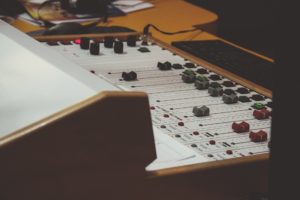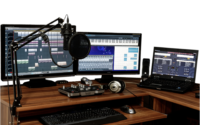Reference Tracks: The Home Studio’s Secret Weapon
 If you’re like me (or really, almost anyone with a home recording studio), you probably want the music coming out of your studio to sound like, and stand up to, the music you hear on iTunes, Spotify, and the radio. I get it, but if you’re not actually referencing that sort of music while you’re working, you’ll never get there. Enter: reference tracks.
If you’re like me (or really, almost anyone with a home recording studio), you probably want the music coming out of your studio to sound like, and stand up to, the music you hear on iTunes, Spotify, and the radio. I get it, but if you’re not actually referencing that sort of music while you’re working, you’ll never get there. Enter: reference tracks.
What Are Reference Tracks?
A reference track is simply a song you use to compare and contrast against your own recording and mixing work. It’s usually either a song you’ve chosen based on the material you’re working with, or (if you’re mixing someone else’s music), a song the musician gave you and said, “we want to sound like this.”
As an example, when I’m mixing my own work, I pull in a Foo Fighters song, an Audioslave song, a Joe Satriani song, and set them up in my DAW. At any time while I’m mixing, I can take a listen to one of my reference tracks and see how my mix is standing up in comparison. Try to find songs in a similar genre to what you’re mixing, and make sure they’re mixes you think sound great as well. You’ll be using these as your barometer.
Reference tracks give you a north star for where to take your mix. Use them to make sure you’re heading in the right direction.
A couple important notes: There will be a large volume difference between your mix-in-progress and your fully mastered reference tracks. Don’t let the volume fool you: bring the reference tracks down to a comparable volume level, rather than trying to get your mix louder.
Two Ways To Use Reference Tracks
The Big Picture
One way to use reference tracks is to consider the “big picture” of your mix – the overall sound. Compare choruses to choruses, verses to verses. Does the low end of your song sound comparable to your reference tracks? What about the midrange where the vocals and guitars are. The top end? Is your mix harsh? Dull? Just right? How about the overall relationships between tracks?
One area I tend to struggle is with vocal level. In a rock mix, I have a tendency to bury the vocals in favor of bigger guitars. Reference tracks help me realize that I need to make the vocal more prominent. I also tend to have the drums too loud, so I’ll bring those down after comparing.
Under The Microscope
I really like to dive in and break apart each element of the mix, and compare it with my reference tracks.
Obviously, my track and the reference tracks aren’t going to sound the same: different musicians, instruments, microphones – heck, different song altogether!
I can listen to my kick drum, and compare it to my references. Is mine hitting as hard? Does it have enough low-end? Enough sound from the beater? Sometimes I’ll pick a song for reference simply for one element, like the snare, or the guitars. Does the snare have enough body? Enough crack? What about the vocals? How much low-end is removed from the vocal? Where’s the meat of it? 800Hz? 1K?
This might seem a little frenetic and OCD, and maybe it is. Stay tuned for an indepth video on how to really dive into this stuff.
Again, you’re not going to make your mix sound exactly like the professional mix you’re holding it up against. You can, however, certainly get your mix into a position where it’ll stand up next to other tracks – getting you one step closer to that “pro” sound.
Use both the big picture and small details of reference tracks. How does your mix compare overall? How does the snare hold up? The bass? The vocal?
Perspective, and Resetting Your Ears
The best thing we can leverage reference tracks for? Perspective. It’s so easy to get lost down the rabbit hole of EQing and tweaking a kick drum, or the bass guitar, that you can lose perspective on the whole song – which is really what matters. Pop in a reference track to make sure you’re not mixing yourself in a corner. It’s a great way to “wake up” your ears, especially if you’ve been mixing for hours on end. (Side note: take frequent breaks – I’m a fan of the Pomodoro method). Make sure you bring in your reference track early. I make a point to listen to my references right after I get a volume and pan balance, before I start adding EQ and compression to my mix. It gives me a target to shoot for: “Here’s where I want to take this mix, and here’s where it’s at to start.” From there, it’s just connecting the dots, and applying your knowledge and skillset.
Promise me this: Please please please don’t fool yourself into thinking your mix is better than the pros because it’s brighter, or bassier, or what-have-you.
Home Studio Secret Weapon
Okay, reference tracks are really useful in just about any studio situation, whether you’re in the bedroom, or a multi-million dollar facility.
Reference tracks are also a great way to learn your room. For us home studio folks, we’re not usually in acoustically perfect rooms. They’re spare bedrooms, a spot on the living room opposite the TV. Your room might have more or less bass. It might have certain frequencies that get a huge boost, or cancel out entirely. Not everything can be corrected with treatment, and unfortunately, we usually can’t rebuild entire rooms to suit our musical needs without angering some roommates, family members, or landlords.
We can use reference tracks to learn those imperfections in our rooms. My challenge to you: Dive into your music collection, and start finding some great-sounding music. Listen to that music in your studio. Learn what good music sounds like in your studio, and leverage that to make your own music sound just as good, and translate just as well to other listening environments
You need to know what good music really sounds like in order to make your own mixes sound great and translate.
Let me know in the comments: What are some amazing-sounding, professionally mixed and mastered songs that you think would make great reference tracks – hip-hop, rock, metal, pop, folk. Let’s help each each other out!







